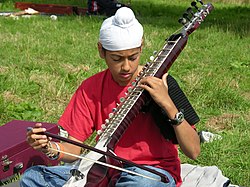Dilruba
 A Sikh boy playing the Dilruba | |
| String instrument | |
|---|---|
| Other names | Dilrupa |
| Classification | Bowed string instrument |
| Part of a series on |
| Sikhism |
|---|
 |
|
The dilruba (also spelt dilrupa)[1] is a bowed musical instrument originating in India. It is slightly larger than an esraj and has a larger, square resonance box. The dilruba holds particular importance in Sikh history.
It attained more global prominence in the 1960s through its appearance in songs by Western artists, such as the Beatles during their psychedelic phase (most notably in the song "Within You Without You").
Etymology[]
The name of the instrument derives from the Persianized Hindustani word دلربا/दिलरुबा (dilrubā), literally meaning "that which ravishes or steals the heart."[2]
History[]
The dilruba was invented around 300 years ago by the 10th Sikh Guru, Guru Gobind Singh, who based it off of the much older and much heavier taus.[1][3] His innovations made it more convenient for the Sikh army (the khalsa) to carry the instrument on horseback.[4] Examining the sources in the prior sentences, an attempt has been made, but they have not provided any valid historical connection of the dilruba to the court of Guru Gobind Singh. Rather, the dilruba was widely known to have been created to accompany the Khayal format of singing many decades later, and therefore would not have found itself in Gurbani Sangeet within any of the Sikh Gurus' courts. In fact, traditional kirtan bearers, such as Bhai Avtar Singh Raagi have clarified the history of the dilruba's creation being tied to the patronage of Maharaja Bhupinder Singh and created by Mahant Gajja Singh.[5]
Construction[]
The structure of the dilruba has a medium-sized sitar-like neck with 20 heavy metal frets. This neck holds on to a long wooden rack of 12-15 sympathetic strings. The dilruba has four main strings, all of which are bowed and made of metal. The soundboard is a stretched piece of goatskin similar to what is found on a sarangi. Sometimes, the instrument has a gourd affixed to the top for balance or for tone enhancement. The instrument can be rested between the knees while the player kneels, or more commonly rested on the knee of the player while sitting, or also on the floor just in front of the player, with their neck leaning on the left shoulder. It is played using a bow, with the other hand moving along the strings above the frets. The player may slide the note up or down to achieve the portamento, or meend, as is characteristic of Indian music.[6]
References[]
- ^ a b Dutta, Madhumita (2008). Let's Know Music and Musical Instruments of India. Star Publications. pp. 22–23. ISBN 978-1-905863-29-7.
- ^ Khalsa, Sukhmandir (4 June 2017). "Dilruba: Ravisher of the Heart". Learning Religions. Retrieved 17 December 2020.
- ^ Dharam Singh (2001). Perspectives on Sikhism. Publication Bureau, Punjabi University. p. 158. ISBN 978-8-1738-0736-7.
- ^ "Rarely played Indian instruments". Radioandmusic.com. 29 March 2018. Retrieved 26 January 2020.
- ^ "Clearing misconceptions on the history of the Dilruba - Bhai Avtar Singh Ji Ragi". Archived from the original on 12 December 2021.
- ^ "Dilruba". Discover Sikhism. 8 March 2020. Retrieved 8 March 2020.
External links[]
- Indian musical instruments
- Sikh music